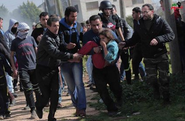22 jan 2016
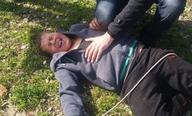
Several Palestinians have been injured, Friday, after Israeli soldiers invaded Nabi Saleh village, northwest of Ramallah, and attacked the weekly nonviolent protest. The army also closed the village, and prevented the Palestinians from entering or leaving it.
The soldiers attacked the Palestinians, holding the weekly nonviolent protest against the Annexation Wall and colonies, and fired several gas bombs and rubber-coated steel bullets on them, causing many injuries.
Today's protest also comes in solidarity with child detainee, Ahmad Manasra, who marks his 13th birthday, in Israeli prisons, the Popular Committee said.
In addition, the soldiers invaded the al-Jalazoun refugee camp, north of Ramallah, and clashed with dozens of local youths, who hurled stones and empty bottles on them. The army fired gas bombs, rubber-coated steel bullets, and concussion grenades.
The soldiers attacked the Palestinians, holding the weekly nonviolent protest against the Annexation Wall and colonies, and fired several gas bombs and rubber-coated steel bullets on them, causing many injuries.
Today's protest also comes in solidarity with child detainee, Ahmad Manasra, who marks his 13th birthday, in Israeli prisons, the Popular Committee said.
In addition, the soldiers invaded the al-Jalazoun refugee camp, north of Ramallah, and clashed with dozens of local youths, who hurled stones and empty bottles on them. The army fired gas bombs, rubber-coated steel bullets, and concussion grenades.
The soldiers also shot and injured two Palestinians with live rounds, after the army ambushed the protesters in Palestinian olive orchards.
Medical sources said Hamza Khaldoun, 21, and Abdullah Anwar, 40, were both shot in their legs, and were moved to Rafidia Hospital.
Eshteiwy also stated that many soldiers hid in an abandoned farm, since morning hours, and assaulted a Palestinian shepherd, identified as Zahi Ali, 48 years of age, as he was searching for some of his sheep. He suffered various cuts and bruises, and received the needed treatment in the town.
Last night, the dozens of soldiers invaded Palestinian olive orchards, and hid there until Friday in an attempt to ambush the protesters, as they take their usual protest route, but the locals uncovered the army's hideout, and rerouted their procession.
The soldiers fired live rounds, rubber-coated steel bullets, and gas bombs, at the protesters, an issue that led to clashes between the army and dozens of locals, who hurled stones and empty bottles on them.
The protesters marched demanding the army to reopen the main road of the village, which has been blockaded for more than 13 years, and demanding the release of all political prisoners.
Medical sources said Hamza Khaldoun, 21, and Abdullah Anwar, 40, were both shot in their legs, and were moved to Rafidia Hospital.
Eshteiwy also stated that many soldiers hid in an abandoned farm, since morning hours, and assaulted a Palestinian shepherd, identified as Zahi Ali, 48 years of age, as he was searching for some of his sheep. He suffered various cuts and bruises, and received the needed treatment in the town.
Last night, the dozens of soldiers invaded Palestinian olive orchards, and hid there until Friday in an attempt to ambush the protesters, as they take their usual protest route, but the locals uncovered the army's hideout, and rerouted their procession.
The soldiers fired live rounds, rubber-coated steel bullets, and gas bombs, at the protesters, an issue that led to clashes between the army and dozens of locals, who hurled stones and empty bottles on them.
The protesters marched demanding the army to reopen the main road of the village, which has been blockaded for more than 13 years, and demanding the release of all political prisoners.
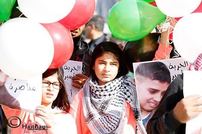
The Popular Committee in Bil’in, in the central West Bank city of Ramallah, has reported that one child was shot with a rubber-coated steel bullet in the head, and dozens of persons suffered the effects of tear gas inhalation, after Israeli soldiers assaulted the weekly nonviolent protest.
The Committee said the child, Bashar Mustafa Khatib, suffered a head injury after the soldiers violently assaulted the weekly protest against the Annexation Wall and colonies, and fired rubber-coated steel bullets, sponge-tipped bullets and gas bombs.
It added that dozens of protesters suffered the effects of tear gas inhalation as the soldiers fired many gas bombs at the protesters and surrounding homes, in the western parts of the village.
Coordinator of the Popular Committee, Abdullah Abu Rahma, said the Palestinians are demanding an end to the ongoing executions and violations carried out by Israeli soldiers and paramilitary settlers, in different parts of occupied Palestine.
Abu Rahma also thanked Sweden and its people for their support of the legitimate Palestinian rights, and called on the Swedish government to investigate Israeli leaders and officials, to hold them accountable for their crimes against the Palestinian people.
The protesters marched from the center of the village, carrying Palestinian and Swedish flags, while children launched balloons colored with the Palestinian flags, in addition to pictures of child detainee Ahmad Manasra, demanding his release, as he marks his 14th birthday today, behind bars.
Israeli, Palestinian and international peace activists marched chanting for liberation and independence, and calling for the release of all detainees, an end to Israel’s illegal annexation of Palestinian lands, and ongoing violations.
Bil'in has been a leading village in the popular nonviolent struggle against the occupation, colonies and the Annexation Wall, for nearly eleven years, and has been subject to ongoing Israeli military violations and escalation.
Many of its residents have been killed, and hundreds of local, and Israeli and international peace activists, have been injured, detained and imprisoned. Video
The Committee said the child, Bashar Mustafa Khatib, suffered a head injury after the soldiers violently assaulted the weekly protest against the Annexation Wall and colonies, and fired rubber-coated steel bullets, sponge-tipped bullets and gas bombs.
It added that dozens of protesters suffered the effects of tear gas inhalation as the soldiers fired many gas bombs at the protesters and surrounding homes, in the western parts of the village.
Coordinator of the Popular Committee, Abdullah Abu Rahma, said the Palestinians are demanding an end to the ongoing executions and violations carried out by Israeli soldiers and paramilitary settlers, in different parts of occupied Palestine.
Abu Rahma also thanked Sweden and its people for their support of the legitimate Palestinian rights, and called on the Swedish government to investigate Israeli leaders and officials, to hold them accountable for their crimes against the Palestinian people.
The protesters marched from the center of the village, carrying Palestinian and Swedish flags, while children launched balloons colored with the Palestinian flags, in addition to pictures of child detainee Ahmad Manasra, demanding his release, as he marks his 14th birthday today, behind bars.
Israeli, Palestinian and international peace activists marched chanting for liberation and independence, and calling for the release of all detainees, an end to Israel’s illegal annexation of Palestinian lands, and ongoing violations.
Bil'in has been a leading village in the popular nonviolent struggle against the occupation, colonies and the Annexation Wall, for nearly eleven years, and has been subject to ongoing Israeli military violations and escalation.
Many of its residents have been killed, and hundreds of local, and Israeli and international peace activists, have been injured, detained and imprisoned. Video
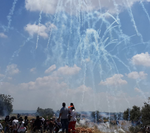
At least eleven Palestinians were injured, Friday, in the village of Ni’lin, northwest of the central West Bank city of Ramallah, after Israeli soldiers assaulted the weekly nonviolent protest.
Medical sources said two of the wounded were shot with rubber-coated metal bullets, and nine others suffered severe effects of tear gas inhalation.
The protest started from the center of the village, while many persons carried Palestinian and Swedish flags, to express gratitude to the Swedish stances in support of the legitimate Palestinian rights of independence and freedom.
Some protesters also carried pictures of imprisoned journalist Mohammad Al-Qeeq, who is held by Israel and continues his hunger strike since November 24, 2015.
Medical sources said two of the wounded were shot with rubber-coated metal bullets, and nine others suffered severe effects of tear gas inhalation.
The protest started from the center of the village, while many persons carried Palestinian and Swedish flags, to express gratitude to the Swedish stances in support of the legitimate Palestinian rights of independence and freedom.
Some protesters also carried pictures of imprisoned journalist Mohammad Al-Qeeq, who is held by Israel and continues his hunger strike since November 24, 2015.
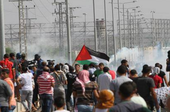
Medical sources in the Gaza Strip have reported, Friday, that at least 17 Palestinians were injured by Israeli army fire, in different parts of the besieged coastal region, and that one of the wounded suffered a serious injury.
Dr. Ashraf al-Qedra, spokesperson of the Health Ministry in Gaza, said the clashes took place in various areas, close to the border fence.
He added that 15 of the wounded Palestinians were shot with live Israeli army rounds, in the al-Farahin area, east of Khan Younis, in the southern part of the Gaza Strip, and that one of them suffered a serious injury.
Dr. Al-Qedra also said that two Palestinians were also injured, while on their way back into the Gaza Strip, after praying in the Al-Aqsa Mosque.
The Israeli army used launchers that can fire dozens of gas bombs, causing many residents to suffer the effects of tear gas inhalation.
Dr. Ashraf al-Qedra, spokesperson of the Health Ministry in Gaza, said the clashes took place in various areas, close to the border fence.
He added that 15 of the wounded Palestinians were shot with live Israeli army rounds, in the al-Farahin area, east of Khan Younis, in the southern part of the Gaza Strip, and that one of them suffered a serious injury.
Dr. Al-Qedra also said that two Palestinians were also injured, while on their way back into the Gaza Strip, after praying in the Al-Aqsa Mosque.
The Israeli army used launchers that can fire dozens of gas bombs, causing many residents to suffer the effects of tear gas inhalation.
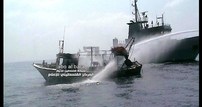
Israeli gunboats on early Friday morning opened heavy machinegun fire on Palestinian fishing vessels setting sail in northern and southern Gaza Strip.
Local sources said sounds of intermittent machinegun fire have been detected in both areas since the crack of dawn. No injuries were reported in the assault.
The Israeli occupation navy have often attacked Palestinian fishermen and ships off Gaza shores, in a flagrant violation of the Cairo-brokered ceasefire accord signed in the wake of the 2014 Israeli offensive on the besieged coastal enclave.
For their part, Israeli occupation soldiers opened machinegun fire at Palestinian farmers to the north east of Rafah city in southern Gaza on Friday morning.
Local sources said that the soldiers at military watchtowers fired at cultivated land lots with no casualties reported.
Local sources said sounds of intermittent machinegun fire have been detected in both areas since the crack of dawn. No injuries were reported in the assault.
The Israeli occupation navy have often attacked Palestinian fishermen and ships off Gaza shores, in a flagrant violation of the Cairo-brokered ceasefire accord signed in the wake of the 2014 Israeli offensive on the besieged coastal enclave.
For their part, Israeli occupation soldiers opened machinegun fire at Palestinian farmers to the north east of Rafah city in southern Gaza on Friday morning.
Local sources said that the soldiers at military watchtowers fired at cultivated land lots with no casualties reported.
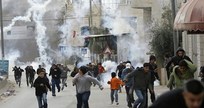
A number of Palestinian citizens suffered from effects of tear gas inhalation Thursday evening as clashes erupted in Juyous town east of Qalqilia to the north of occupied West Bank.
The clashes broke out when Israeli Occupation Forces (IOF) violently stormed the town and deployed in large numbers throughout its neighborhoods, local sources reported.
Tear gas bombs and live rounds were heavily fired during the clashes, which led to a number of injuries among local youths.
On the other hand, an Israeli settler was slightly injured Thursday afternoon after Molotov cocktails were thrown at a number of Israeli cars near Maale Adumim settlement illegally built in occupied Jerusalem.
The Israeli vehicles sustained material damage, Hebrew media sources said.
Meanwhile, violent clashes erupted earlier Thursday in Beit Furik and Beit Dajan towns east of Nablus.
Local sources affirmed to the PIC reporter that clashes were reported in Beit Dajan when IOF soldiers stormed the town amid heavy firing of tear gas bombs.
An Israeli soldier was reportedly injured during the clashes, the sources added.
Similar confrontations broke out in Beit Furik, where a number of local youths were detained and investigated.
The clashes broke out when Israeli Occupation Forces (IOF) violently stormed the town and deployed in large numbers throughout its neighborhoods, local sources reported.
Tear gas bombs and live rounds were heavily fired during the clashes, which led to a number of injuries among local youths.
On the other hand, an Israeli settler was slightly injured Thursday afternoon after Molotov cocktails were thrown at a number of Israeli cars near Maale Adumim settlement illegally built in occupied Jerusalem.
The Israeli vehicles sustained material damage, Hebrew media sources said.
Meanwhile, violent clashes erupted earlier Thursday in Beit Furik and Beit Dajan towns east of Nablus.
Local sources affirmed to the PIC reporter that clashes were reported in Beit Dajan when IOF soldiers stormed the town amid heavy firing of tear gas bombs.
An Israeli soldier was reportedly injured during the clashes, the sources added.
Similar confrontations broke out in Beit Furik, where a number of local youths were detained and investigated.

Israeli settlers, on Thursday, attacked a number of Palestinian homes in the center of Hebron, throwing stones and verbally abusing residents, according to a local activist with Israeli rights group B'Tselem.
Raed Abu Rmeila said settlers attacked the homes of Fawaz Qafisha, Shams al-Zatari, and Hussein al-Zatari on al-Sahla Street, near the flashpoint Ibrahimi Mosque in the Old City of the southern occupied West Bank city of Hebron.
Rmeila said settlers, accompanied by Israeli soldiers, broke several doors in the area and threw rocks at the homes, while screaming insults at the families. The settlers were reportedly positioned on rooftops as well as the main street.
The activist added, according to Ma'an, that Israeli forces responded by firing tear gas at Palestinian homes, causing several residents to suffer severe tear gas inhalation.
An Israeli army spokesperson said that "(Israeli) forces received reports of clashes between Palestinians and Israelis in Hebron, and security forces called for both sides to halt and used riot dispersal means in order to prevent a further escalation of violence."
Mistreatment of Palestinians in the Hebron area has been common since the city was divided in the 1990s after a US-born settler, Baruch Goldstein, massacred 29 Palestinians inside the Ibrahimi Mosque.
The majority of the city was placed under the jurisdiction of the Palestinian Authority, while the Old City and surrounding areas were placed under Israeli military control in a sector known as H2.
The area is home to 30,000 Palestinians and around 800 Israeli settlers who live under the protection of Israeli forces. Hebron residents frequently report attacks and harassment by the settlers carried out in the presence of the forces.
Since November, the residential area of the Old City off Al-Shuhada street, as well as the Tel Rumeida area, has been designated a closed military zone by the Israeli army following a number of violent encounters in the area. The order was renewed earlier this month, banning all entry to the areas aside from its Palestinian residents and Israeli settlers.
Palestinian residents were forced to register in order to gain access to their homes and have reported higher-than-average difficulty travelling through the nearly 20 checkpoints that stand across the Old City.
Raed Abu Rmeila said settlers attacked the homes of Fawaz Qafisha, Shams al-Zatari, and Hussein al-Zatari on al-Sahla Street, near the flashpoint Ibrahimi Mosque in the Old City of the southern occupied West Bank city of Hebron.
Rmeila said settlers, accompanied by Israeli soldiers, broke several doors in the area and threw rocks at the homes, while screaming insults at the families. The settlers were reportedly positioned on rooftops as well as the main street.
The activist added, according to Ma'an, that Israeli forces responded by firing tear gas at Palestinian homes, causing several residents to suffer severe tear gas inhalation.
An Israeli army spokesperson said that "(Israeli) forces received reports of clashes between Palestinians and Israelis in Hebron, and security forces called for both sides to halt and used riot dispersal means in order to prevent a further escalation of violence."
Mistreatment of Palestinians in the Hebron area has been common since the city was divided in the 1990s after a US-born settler, Baruch Goldstein, massacred 29 Palestinians inside the Ibrahimi Mosque.
The majority of the city was placed under the jurisdiction of the Palestinian Authority, while the Old City and surrounding areas were placed under Israeli military control in a sector known as H2.
The area is home to 30,000 Palestinians and around 800 Israeli settlers who live under the protection of Israeli forces. Hebron residents frequently report attacks and harassment by the settlers carried out in the presence of the forces.
Since November, the residential area of the Old City off Al-Shuhada street, as well as the Tel Rumeida area, has been designated a closed military zone by the Israeli army following a number of violent encounters in the area. The order was renewed earlier this month, banning all entry to the areas aside from its Palestinian residents and Israeli settlers.
Palestinian residents were forced to register in order to gain access to their homes and have reported higher-than-average difficulty travelling through the nearly 20 checkpoints that stand across the Old City.
21 jan 2016
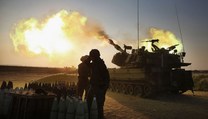
Israeli army on Thursday morning deployed military reinforcements including artillery batteries in the vicinity of Gaza Strip in the wake of killing a Palestinian man after alleged attempt of planting of mines in northern Gaza Strip last week.
The Israeli newspaper of Yedioth Ahronoth pointed out that such reinforcements aim at enhancing the immediate response to any shooting operations by Palestinians.
For his part, the office of the Israeli army spokesperson said that this procedure is part of the Israeli regular defense plans. Observers; however, opined that these moves aim at deviating attention from Jerusalem Intifada.
Israeli media, meanwhile, continued their incitement against Hamas Movement. The Israeli Channel Seven reported that the direct threat to Israel is Hamas’s armed cells either in Gaza or in the West Bank.
The Israeli newspaper of Yedioth Ahronoth pointed out that such reinforcements aim at enhancing the immediate response to any shooting operations by Palestinians.
For his part, the office of the Israeli army spokesperson said that this procedure is part of the Israeli regular defense plans. Observers; however, opined that these moves aim at deviating attention from Jerusalem Intifada.
Israeli media, meanwhile, continued their incitement against Hamas Movement. The Israeli Channel Seven reported that the direct threat to Israel is Hamas’s armed cells either in Gaza or in the West Bank.
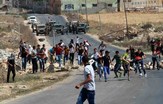
Three Palestinians were injured in clashes with Israeli soldiers who stormed Ourif town to the south of Nablus city on Thursday evening.
Quds Press agency revealed that Israeli troops opened their gunfire and unleashed tear gas canisters at Palestinians. The Israeli shooting led to mild injuries of three young men by rubber bullets.
Israeli forces had stormed several areas in Nablus city at dawn Wednesday. The forces arrested two residents and injured three others in Tel town in western Nablus as well as in Balata refugee camp to the east of the city.
Quds Press agency revealed that Israeli troops opened their gunfire and unleashed tear gas canisters at Palestinians. The Israeli shooting led to mild injuries of three young men by rubber bullets.
Israeli forces had stormed several areas in Nablus city at dawn Wednesday. The forces arrested two residents and injured three others in Tel town in western Nablus as well as in Balata refugee camp to the east of the city.
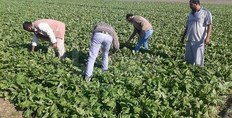
Israeli airplanes Thursday morning destroyed Palestinians’ plantings near al-Shujaiya district in Gaza Strip after spraying it with harmful pesticides.
The Israeli planes crossed Gaza border for tens of meters and caused great damage to the crops after spraying them with crop-killing chemicals. Palestinian farmers underlined that Israeli forces deliberately practice such aggressive attacks.
Israeli forces in the morning opened their machinegun fire at Palestinian farmers in the same area in order to make them leave their lands. No casualties were reported.
The Israeli planes crossed Gaza border for tens of meters and caused great damage to the crops after spraying them with crop-killing chemicals. Palestinian farmers underlined that Israeli forces deliberately practice such aggressive attacks.
Israeli forces in the morning opened their machinegun fire at Palestinian farmers in the same area in order to make them leave their lands. No casualties were reported.
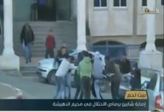
One Of The Wounded Palestinians In Bethlehem
Palestinian sources have reported that dozens of Israeli soldiers invaded, on Thursday at dawn, various communities in the West Bank district of Bethlehem, injured two and kidnapped eight others.
Mohammad Abu Rayyan, the deputy head of the Red Crescent’s Emergency Unit in Bethlehem, said the soldiers shot, in the Deheishe refugee camp, two Palestinians with live rounds in their thighs, before local medics rushed them to Beit Jala and the al-Yamama hospitals in Bethlehem.
The soldiers also invaded and searched many homes, and kidnapped two Palestinians, identified as Mufti Marouf al-Masri, 21, and Anas Ezzat Abu Dayya, 21.
Eyewitnesses said the invasion was carried out by dozens of soldiers, and undercover officers, leading to clashes with local youths, who hurled stones and empty bottles on them.
The clashes were largely concentrated at the main entrance of the refugee camp.
The soldiers fired live rounds, gas bombs and concussion grenades, and occupied rooftops of many homes, before using them as monitoring towers.
In addition, the soldiers invaded the al-‘Arouj village, east of Bethlehem, searched and ransacked homes, an kidnapped four Palestinians identified as Rabe'a Mustafa al-'Arouj, 27, (wife of a political prisoner identified as Ismael al-'Arouj), Fidda (his mother), 52, in addition to his brothers Mohammad, 30, and Ja'far, 29.
In Beit Fajjar town, south of Bethlehem, the soldiers kidnapped two Palestinians identified as Soheib Hamza Thawabta, 22, and Khalid Waleed Thawabta, 17.
Palestinian sources have reported that dozens of Israeli soldiers invaded, on Thursday at dawn, various communities in the West Bank district of Bethlehem, injured two and kidnapped eight others.
Mohammad Abu Rayyan, the deputy head of the Red Crescent’s Emergency Unit in Bethlehem, said the soldiers shot, in the Deheishe refugee camp, two Palestinians with live rounds in their thighs, before local medics rushed them to Beit Jala and the al-Yamama hospitals in Bethlehem.
The soldiers also invaded and searched many homes, and kidnapped two Palestinians, identified as Mufti Marouf al-Masri, 21, and Anas Ezzat Abu Dayya, 21.
Eyewitnesses said the invasion was carried out by dozens of soldiers, and undercover officers, leading to clashes with local youths, who hurled stones and empty bottles on them.
The clashes were largely concentrated at the main entrance of the refugee camp.
The soldiers fired live rounds, gas bombs and concussion grenades, and occupied rooftops of many homes, before using them as monitoring towers.
In addition, the soldiers invaded the al-‘Arouj village, east of Bethlehem, searched and ransacked homes, an kidnapped four Palestinians identified as Rabe'a Mustafa al-'Arouj, 27, (wife of a political prisoner identified as Ismael al-'Arouj), Fidda (his mother), 52, in addition to his brothers Mohammad, 30, and Ja'far, 29.
In Beit Fajjar town, south of Bethlehem, the soldiers kidnapped two Palestinians identified as Soheib Hamza Thawabta, 22, and Khalid Waleed Thawabta, 17.
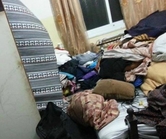
Palestinian Home After The Soldiers Searched It Two Days Ago
One Palestinian was kidnapped, and three others suffered moderate wounds, after Israeli soldiers invaded, overnight, the central West Bank city of Tubas, and stormed homes and clashed with local youths.
The WAFA News Agency said the soldiers searched and ransacked many homes, and kidnapped Ali Ahmad Masa'id, 21, before taking him to an unknown destination.
The invasion led to clashes between the local youths, and the soldiers, who fired live rounds, rubber-coated metal bullets and gas bombs, causing three Palestinians to suffer mild-to-moderate wounds.
One Palestinian was kidnapped, and three others suffered moderate wounds, after Israeli soldiers invaded, overnight, the central West Bank city of Tubas, and stormed homes and clashed with local youths.
The WAFA News Agency said the soldiers searched and ransacked many homes, and kidnapped Ali Ahmad Masa'id, 21, before taking him to an unknown destination.
The invasion led to clashes between the local youths, and the soldiers, who fired live rounds, rubber-coated metal bullets and gas bombs, causing three Palestinians to suffer mild-to-moderate wounds.
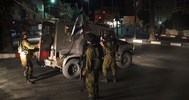
Over 25 Palestinians, including minors, were kidnapped by the Israeli occupation forces (IOF) in a mass-abduction sweep launched across cities of the West Bank and Occupied Jerusalem at dawn on Thursday.
Sources-based in Jenin said the IOF rolled into the city in over 12 army jeeps and wreaked havoc on a civilian home before they subjected the inhabitants to exhaustive questioning and carried out combing operations in the area.
Violent clashes burst out shortly after the IOF rolled into Tubas and attacked the Palestinian protesters with randomly-shot waves of bullet fire.
The IOF also ravaged a civilian home in Tubas and interrogated the locals before they cordoned the residential alleys and kidnapped 21-year-old Ali Ahmad Musaed.
Three Palestinians were, meanwhile, injured by Israeli bullet fire in Nablus city.
Local sources said the IOF stormed Tel town, in western Nablus, and kidnapped the 41-year-old citizen Asaad Yameen after they rummaged into his family home. Another citizen was also kidnapped in the assault.
Both Jihad Eshteyeh, 17, and Hamed Ramadan, 21, were hit with Tutu bullets and were rushed to a hospital to be urgently treated for their moderate wounds.
The third casualty was identified as Issa Hashash, who was shot and injured during violent clashes with the IOF in the Balata refugee camp.
The IOF further kidnapped seven Palestinians from Bethlehem, including the 28-year-old wife of prisoner Ismail Al-Arouj and his two brothers, following abrupt assaults on Palestinian civilian homes.
The IOF attacked the Palestinian protesters with live ammunition, rubber bullets, and teargas canisters, resulting in several injuries and suffocation cases.
Two Palestinian youngsters were evacuated to hospital after they were shot and injured in their thighs. Others were treated for critical breathing disorders due to heavy inhalation of teargas.
Al-Khalil based sources said the IOF kidnapped seven Palestinians from the city.
The IOF also kidnapped three Palestinians from Ramallah and al-Bireh and three others from Tulkarem province.
The campaign culminated in the abduction of two children from Occupied Jerusalem city, one among whom was identified as 14-year-old Muhammad Yaghmour.
Sources-based in Jenin said the IOF rolled into the city in over 12 army jeeps and wreaked havoc on a civilian home before they subjected the inhabitants to exhaustive questioning and carried out combing operations in the area.
Violent clashes burst out shortly after the IOF rolled into Tubas and attacked the Palestinian protesters with randomly-shot waves of bullet fire.
The IOF also ravaged a civilian home in Tubas and interrogated the locals before they cordoned the residential alleys and kidnapped 21-year-old Ali Ahmad Musaed.
Three Palestinians were, meanwhile, injured by Israeli bullet fire in Nablus city.
Local sources said the IOF stormed Tel town, in western Nablus, and kidnapped the 41-year-old citizen Asaad Yameen after they rummaged into his family home. Another citizen was also kidnapped in the assault.
Both Jihad Eshteyeh, 17, and Hamed Ramadan, 21, were hit with Tutu bullets and were rushed to a hospital to be urgently treated for their moderate wounds.
The third casualty was identified as Issa Hashash, who was shot and injured during violent clashes with the IOF in the Balata refugee camp.
The IOF further kidnapped seven Palestinians from Bethlehem, including the 28-year-old wife of prisoner Ismail Al-Arouj and his two brothers, following abrupt assaults on Palestinian civilian homes.
The IOF attacked the Palestinian protesters with live ammunition, rubber bullets, and teargas canisters, resulting in several injuries and suffocation cases.
Two Palestinian youngsters were evacuated to hospital after they were shot and injured in their thighs. Others were treated for critical breathing disorders due to heavy inhalation of teargas.
Al-Khalil based sources said the IOF kidnapped seven Palestinians from the city.
The IOF also kidnapped three Palestinians from Ramallah and al-Bireh and three others from Tulkarem province.
The campaign culminated in the abduction of two children from Occupied Jerusalem city, one among whom was identified as 14-year-old Muhammad Yaghmour.
